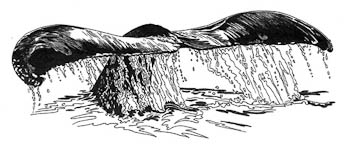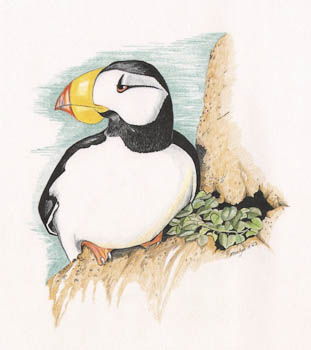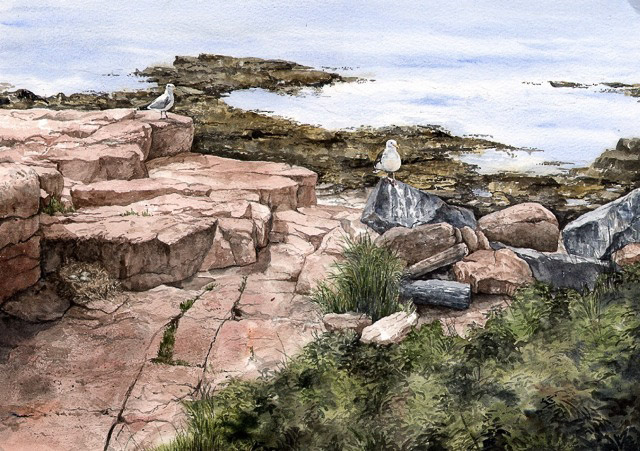THROUGH AN ARTIST'S EYE:
MAINE'S MONHEGAN, MT. DESERT, AND GREAT DUCK ISLANDS
 June 3-11, 2012 9 Days/8 Nights June 3-11, 2012 9 Days/8 Nights
Sarah Drummond and Marilyn Hailbronner
Coastal Maine is not a still life—nothing is ever still or unchanging where the land meets the sea. Life along coastal edges tends to be a rough and tumble existence. When the storms of winter rage along the coast, it seems impossible that such a harsh world could embrace so many different lifeforms. With the coming of spring, coastal and island habitats reveal their special magic to those who immerse themselves in the rhythm of life at the sea's edge. When you stand atop Cadillac Mountain in Acadia National Park, you see granite bedrock polished and etched with grooves marking the passage of a mile-thick ice sheet that once flowed southward out of the frozen Arctic. This massive complex of glaciers spread across the entire New England region, including all of Maine, the Gulf of Maine, and east to Maine's outer banks. When the glaciers finally receded some 13,000 years ago, the mainland rebounded from its icy shroud, rising out of the sea by more than two hundred feet in many places. Master landscape artists—glacial erosion and wave action—created much of the magnificent coastal scenery we see today. Maine's coastline corkscrews in and out to form picturesque coves and sheltering bays, more than a dozen dramatic peninsulas, cliff-bound headlands, and a wealth of offshore islands. The islands themselves are the much-eroded remnants of a coastal mountain range overrun by the same glaciers that sculpted the mainland.
Our island-based artist's workshop focuses on the many ways that landscape complexity and biological diversity are linked, as well as the unique adaptations that enable plants and animals to survive in a dynamic water-shaped world. As we explore the islands, artists Sarah  Drummond and Marilyn Hailbronner will offer workshops emphasizing quick sketching and drawing, detailed studies in pen-and-ink or on scratchboard, and watercolor techniques—enriching our natural history observations, conveying the dance of light and shadow, and creating a sense of place. Drummond and Marilyn Hailbronner will offer workshops emphasizing quick sketching and drawing, detailed studies in pen-and-ink or on scratchboard, and watercolor techniques—enriching our natural history observations, conveying the dance of light and shadow, and creating a sense of place.
We begin and end our island sojourn in Portland, Maine, heading first to Rockland's famous Farnsworth Art Museum and the Wyeth Center, home to a vast collections of works by Maine's best known artists, including N.C., James, and Andrew Wyeth, Rockwell Kent, Robert Henri, and Edward Hopper. Traveling by ferry to fabled Monhegan Island, which lies a dozen nautical miles off the coast, in the Gulf of Maine, we'll spend several days exploring an island that is truly a world apart—its remoteness and magnificent scenery inspiring artists for more than 100 years. Monhegan is small, just a mile and a half long, and was purchased and settled about 1790 by two families, the Trefethrens and Sterlings. Thanks to preservation efforts by the Monhegan Associates, a resident land trust, nearly 70% of the island is protected wild land, completely roadless, and its architectural integrity remains little changed. We'll spend our days hiking the superb network of trails that provide access to the island's rocky headlands, watch for seabirds and whales from the cliffs and beaches, experience the evergreen magic of Cathedral Woods, and visit Monhegan Light, a classic Maine lighthouse that was lit by whale oil for more than 100 years— with plenty of time for sketching as we go.
 Moving northward to Mount Desert Island, the largest of Maine's coastal islands, we'll enjoy several days exploring Acadia National Park's diverse environments—from the summit of Cadillac Mountain to the deciduous woodlands, peat bogs and ponds, the cliffs, and rock-bound intertidal zone. The timing of our visit allows us to miss the crowds and to get off the beaten track. Sea conditions permitting, we'll conclude our island sojourn with a boat trip to uninhabited Great Duck Island. This tiny island provides critical nesting habitat for seabirds such as Leach's storm petrel and black guillemot. We'll visit College of the Atlantic's research station and learn about ongoing seabird research. There is no better way to end our Maine island sojourn than by spending an afternoon observing, sketching, and photographing daily life in a seabird colony—a total sensory experience! Moving northward to Mount Desert Island, the largest of Maine's coastal islands, we'll enjoy several days exploring Acadia National Park's diverse environments—from the summit of Cadillac Mountain to the deciduous woodlands, peat bogs and ponds, the cliffs, and rock-bound intertidal zone. The timing of our visit allows us to miss the crowds and to get off the beaten track. Sea conditions permitting, we'll conclude our island sojourn with a boat trip to uninhabited Great Duck Island. This tiny island provides critical nesting habitat for seabirds such as Leach's storm petrel and black guillemot. We'll visit College of the Atlantic's research station and learn about ongoing seabird research. There is no better way to end our Maine island sojourn than by spending an afternoon observing, sketching, and photographing daily life in a seabird colony—a total sensory experience!
Price: $2,500 (includes a $500 deposit)
Group size: 10
Trip Rating: 2-3
Price includes: all instruction and guide services, all van, ferry and small boat transportation, 8 nights' lodging, all meals (beginning with dinner on June 3 and ending with dinner on June 10), service gratuities as appropriate, and all entrance fees.
Does not include roundtrip airfare to Portland, Maine from your point of departure, meals other than those listed, or art supplies. |
